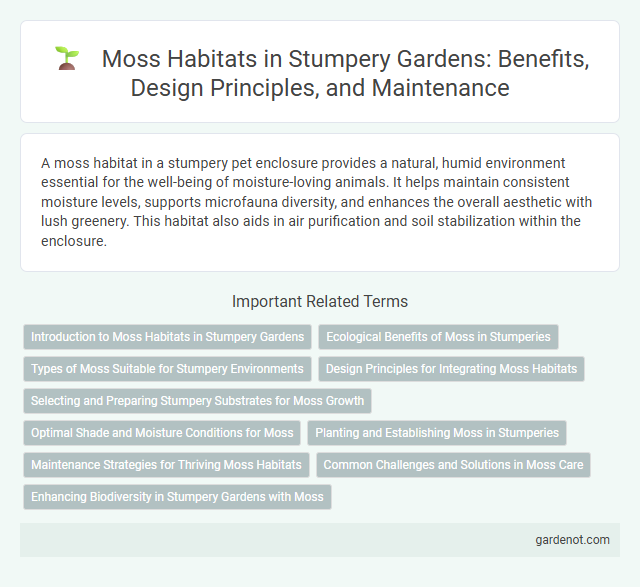A moss habitat in a stumpery pet enclosure provides a natural, humid environment essential for the well-being of moisture-loving animals. It helps maintain consistent moisture levels, supports microfauna diversity, and enhances the overall aesthetic with lush greenery. This habitat also aids in air purification and soil stabilization within the enclosure.
Introduction to Moss Habitats in Stumpery Gardens
Moss habitats in stumpery gardens create ideal environments by combining decaying wood, shaded areas, and moisture retention. These conditions mimic natural forest floors, supporting diverse bryophyte species and enhancing garden biodiversity. Stumpery mosses contribute to soil stability and provide microhabitats for invertebrates, promoting ecological balance.
Ecological Benefits of Moss in Stumperies
Moss in stumperies creates a moist, shaded habitat that supports a diverse range of microfauna and invertebrates, enhancing local biodiversity. Its ability to retain water helps regulate soil moisture levels, preventing erosion and promoting healthy root systems for surrounding plants. Moss also acts as a natural filter, improving air quality and contributing to carbon sequestration within the ecosystem.
Types of Moss Suitable for Stumpery Environments
Shaded, moist environments in stumperies favor moss species such as Hypnum, Polytrichum, and Dicranum, which thrive on decaying wood and retain moisture effectively. These mosses contribute to biodiversity by supporting microhabitats for invertebrates and promoting fungal symbiosis essential for wood decomposition. Selecting moss species with varying textures and growth patterns enhances the visual appeal and ecological function of the stumpery habitat.
Design Principles for Integrating Moss Habitats
Design principles for integrating moss habitats in stumperies emphasize creating shaded, moist environments that mimic natural forest floors, supporting diverse moss species. Selecting decayed wood with varied textures and orientations enhances microhabitats, promoting moss colonization and growth. Maintaining consistent humidity and minimizing direct sunlight are crucial for sustaining moss vitality within the stumpery ecosystem.
Selecting and Preparing Stumpery Substrates for Moss Growth
Selecting and preparing substrates for moss growth in a stumpery involves choosing decayed wood, bark, and shaded soil rich in organic matter to mimic natural forest floors. Ensuring substrates remain moist yet well-drained promotes optimal moss establishment by maintaining humidity without waterlogging. Incorporating slightly acidic conditions with a pH around 5.0 to 6.0 supports diverse moss species, enhancing the stumpery's ecological balance and aesthetic appeal.
Optimal Shade and Moisture Conditions for Moss
Moss thrives in habitats with optimal shade and consistent moisture, preferring dappled or full shade to prevent dehydration and promote lush growth. Ideal moisture conditions include high humidity and damp substrates such as decaying wood or shaded soil, which retain water effectively without waterlogging. Maintaining these microclimate factors supports the health and diversity of moss species in a stumpery environment.
Planting and Establishing Moss in Stumperies
Creating an ideal moss habitat in stumperies involves selecting shaded, moist areas with acidic, well-drained soil to promote healthy moss growth. Establishing moss can be accelerated by transplanting fragments from established moss beds or using a moss slurry, which combines moss fragments with water and a binding agent to encourage adhesion to stumps and surrounding surfaces. Regular misting and maintaining consistent humidity levels are essential to ensure successful moss establishment and long-term vitality in the stumpery environment.
Maintenance Strategies for Thriving Moss Habitats
Maintaining optimal moisture levels is crucial for thriving moss habitats in stumperies, as mosses require consistently damp, shaded environments to flourish. Regularly removing competing vegetation and debris prevents moss desiccation while preserving soil acidity supports healthy moss growth. Implementing minimal disturbance practices and monitoring microclimate conditions ensure sustainable moss development and biodiversity within the stumpery ecosystem.
Common Challenges and Solutions in Moss Care
Moss habitats often face challenges such as excessive drying, poor air circulation, and inadequate shade, which can inhibit growth and cause moss to deteriorate. Maintaining consistent moisture levels through regular misting, ensuring partial shade, and improving ventilation with light pruning helps create an optimal environment for moss health. Using organic mulch and avoiding chemical fertilizers reduces soil disruption, promoting moss resilience against environmental stressors in a stumpery setting.
Enhancing Biodiversity in Stumpery Gardens with Moss
Mosses create a vital habitat within stumpery gardens, providing moisture retention and shelter for microfauna such as springtails and nematodes, which contribute to soil health and nutrient cycling. Their presence enhances biodiversity by supporting a variety of invertebrates and fungi that form symbiotic relationships with decaying wood, accelerating decomposition processes. Incorporating diverse moss species in stumpery design promotes a resilient ecosystem, fostering increased plant growth and natural pest control.
Moss habitat Infographic

 gardenot.com
gardenot.com